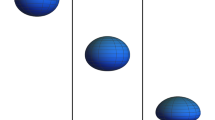Abstract
In this paper we present a new type of extended uncertainty principle (EUP) of the form [X, P] = i(1 − q|X|) and show that it has the non-zero minimal momentum. For this EUP we discuss the classical mechanics in the curved space, deformed calculus, deformed quantum mechanics and Bohr-Sommerfeld quantization.





Similar content being viewed by others
References
Snyder, H.S.: Phys. Rev. 71, 38 (1947)
Yang, C.N.: Phys. Rev. 72, 874 (1947)
Kempf, A., Mangano, G., Mann, R.B.: Phys. Rev. D 52, 1108 (1995)
Mignemi, S.: Mod. Phys. Lett. A25, 1697 (2010)
Chung, W.S., Hassanabadi, H.: J. Korean Phys. Soc. 71, 1 (2017)
Chung, W.S., Hassanabadi, H.: Mod. Phys. Lett. A 32, 26 (2017)
Mignemi, S.: Phys. Rev. D 84, 025021 (2011)
Filho, R., Braga, J., Lira, J., Andrade, J. Jr.: Phys. Lett. B 755, 367 (2016)
Alsing, P.M., Evans, J.C., Nandi, K.K.: Gen. Relativ. Gravit. 33, 1459 (2001)
Bjerrum-Bohr, N.E.J., Donoghue, J.F., Holstein, B.R.: Phys. Rev. D 68, 084005 (2003)
Donoghue, J.F., Holstein, B.R.: Am. J. Phys. 54, 827 (1986)
Stodolsky, L.: Gen. Relativ. Gravit. 11, 391 (1979)
Gupta, S.N.: Can. J. Phys. 35, 961 (1957)
Kaplan, L., Maitra, N.T., Heller, E.J.: Phys. Rev. A 56, 2592 (1997)
Schulman, L.S.: Techniques and Applications of Path Integration. Wiley, New York (1981)
da Costa, R.C.T.: Phys. Rev. A 23, 1982 (1981)
Tsallis, C.: J. Stat. Phys. 52, 479 (1988)
Tsallis, C.: Introduction to Nonextensive Statistical Mechanics: Approaching a Complex World. Springer (2009)
Acknowledgements
The author acknowledges to reviewer for his (or her) helpful comments. This work was supported by the National Research Foundation of Korea Grant funded by the Korean Government (NRF-2015R1D1A1A01057792).
Author information
Authors and Affiliations
Corresponding author
Additional information
Publisher’s Note
Springer Nature remains neutral with regard to jurisdictional claims in published maps and institutional affiliations.
Appendices
Appendix A
When x > 0, the deformed exponential function can also be written as
When x < 0, the deformed exponential function can also be written as
If we introduce the q-number as
we have
where
and
The q-Gamma function is defined by
Limiting q → 0, the (129) reduces to an ordinary Gamma function. For z = N, (N = 0, 1, 2, ⋯), we have
The q-Gamma function satisfies the following recurrence relation:
This is the q-analogue of basic functional relation for the ordinary Gamma function. The q-Gamma function for arbitrary number z can also be written as follows:
Indeed, replacing z with z + 1, we have
A glance at the (132) shows
and
From the definition (132), we have the third definition of q-Gamma function as follows:
Using the (136), we find the following relations for the product of two q-Gamma functions:
Inserting z = 1/2 into the (137), we have
The q-deformed digamma function is defined as
Using the property of the q-log function, we have the following result:
Inserting z = 0 into the (140) yields
where the q-analogue of Euler constant is then given by
Appendix B: Nikiforov - Uvarov Method
In this technique, we solve a second-order differential equation in the form of a hypergeometric-type or a general Schrodinger-type equation [1, 2],
For calculation of eigenvalues and corresponding wave functions of the energy by using this approach, we try to obtain the following parameters
The energy relation using the set of parameters mentioned above forms an energy equation as,
Also, the final wave function relation in NU method will be of the following form,
If α3 = 0 , the relation (147) will be reduced to
Rights and permissions
About this article
Cite this article
Chung, W.S. The New Type of Extended Uncertainty Principle and Some Applications in Deformed Quantum Mechanics. Int J Theor Phys 58, 2575–2591 (2019). https://doi.org/10.1007/s10773-019-04146-z
Received:
Accepted:
Published:
Issue Date:
DOI: https://doi.org/10.1007/s10773-019-04146-z



